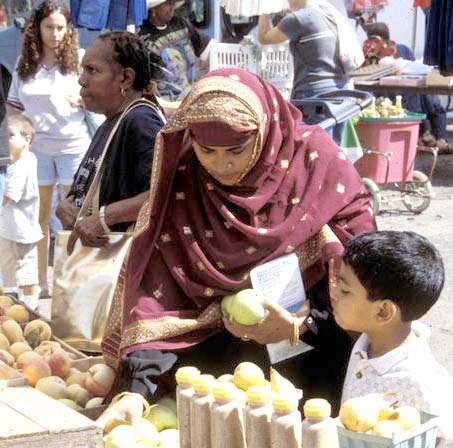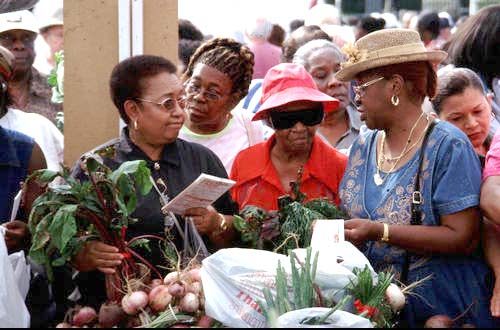A biweekly newsletter with public space news, resources, and opportunities.
A curated dispatch on all things public markets plus the latest announcements from the Market Cities Program.
By Benjamin Fried
The next time you go to a public market, ask one of the vendors what they like best about selling there. To Juliet Anderson, a vendor at the Berkeley Flea Market, the answer is obvious: "The people that I meet." In a nutshell, that's what separates public markets from other economic development projects: A good public market is not only an economic engine, it's also a social gathering place that builds community.

It's this combination of economic and social impact that separates public markets from "big project" economic development. The common types of big projects -- highway construction, office complexes, convention centers -- have disrupted the urban fabric, drained life from public spaces, and led in many cases to further economic stagnation. What's more, the jobs generated by these projects have tended to be temporary or menial. Public and private agencies are beginning to recognize that new definitions of "urban revitalization" and "economic development" are needed. That's where public markets come in.
Public markets are uniquely suited to fill a host of crucial roles: lively gathering place, small business incubator, and food security provider, to name a few. Yet markets remain a hard sell. With that in mind, PPS and Partners for Livable Communities, funded by the Ford Foundation, researched specific social and economic benefits markets provide to low-income communities.
The research, which consisted of interviews with 671 customers and 157 vendors from eight markets, clearly illustrates the opportunities markets provide for new entrepreneurs with little capital. Since start-up costs are so low (54% of vendors needed less than $1000 to begin selling), an overwhelming majority of vendors surveyed (83%) were able to self-finance.
"There was no need to borrow money," said Anderson, who began her bead business 11 years ago. "I just started up with one table and then added another, and I kept putting money back into the business. It just took off."
"The start-up cost was not much at all except for the investment in a table saw," said Furnand Panhuise, a vendor at Berkeley Flea Market who started selling handmade woodwork full-time after a neighbor commended a table he crafted at home.
Although selling at markets tends not to be vendors' only source of income, it still contributes significantly to quality of life and upward mobility. For instance, Anderson does not sell full-time, but plans to continue vending to support herself after she retires.
Among the more serious vendors, most reported that market income helped them make major investments. Many said selling at the market enabled them to expand their primary business or open a new business altogether. Others used market income to become homeowners or pay for children's education.
Vendor income captures only part of the economic benefits of public markets; it's the spin-off effects that give the surrounding neighborhood the biggest boost. Consider that 60% of market customers surveyed said they had visited or planned to visit other stores in the neighborhood the same day, and of that group 60% said they only visited those stores on market days; it's clear that markets have a profound effect on local economies that reaches far beyond the vendors themselves.
There are few types of places that offer the kind of group interaction you find at markets, and customers know this. Customer interviews revealed that atmosphere and sense of community are among the main draws at markets. When asked why they come to the market, customers' most common replies (after "products") were "place" and "people." Perhaps even more telling, when asked "What is the greatest benefit of the market to the community?" the most popular response was that the market brought people together.

Vendors were even more enthusiastic about the social joys of markets than customers. Fully 59% cited "people" as what they like best about selling at the market. "I enjoy dealing with the public, and over the years I've developed some pretty good friendships," said Panhuise. "You meet new people all the time."
Markets feel like exceptional gathering places in part because they attract people of all ages. No age group predominates, yet all are represented. Markets are seen as neutral spaces that belong to no single age group, giving them a multi-generational character and sense of community like few other places.
Of the eight markets PPS surveyed, six rely on some form of subsidy to operate. Even markets destined for success can take years to operate without subsidies.
Sometimes, markets can demonstrate in straightforward economic terms that they are worth the public expenditure. For example, the Chinatown Night Market in San Francisco receives a grant from the city and county for $200,000, but the city recoups more than that amount through sales tax revenue and parking fees generated by a city-owned garage that would otherwise be underutilized.
Other markets occupy a more precarious situation. East New York Farms!, a four-year-old farmers and crafts market located in a low-income area of Brooklyn, currently receives 80% of its revenues through a federal program that distributes coupons to seniors, pregnant women, and postpartum mothers to spend specifically at farmers markets. "There's no telling that Congress will allow this program to go on for much longer," said market manager Salima Jones.

One of the main obstacles facing newer markets is the need to reach customers beyond the immediate neighborhood: Successful markets draw customers from up to seven miles away. East New York Farms! performs prodigious outreach through youth programs, nutrition workshops, and cooking demonstrations, but a limited marketing budget hampers their ability to attract a broader customer base. "We have our group of committed farmers market shoppers, but certainly the exposure to a larger group is what we need," said Jones.
There are numerous other factors that ultimately determine success. Like any retail business, a market can't survive without certain essentials: product, price, good marketing, lean management, and, of course, "location, location, location." To succeed as a social gathering place, a public market must also be an actively programmed and managed public space; customers need to see the market as more than a forum to buy and sell. PPS's continuing research for the Ford Foundation and Kellogg Foundation will further advance our understanding of how to sustain markets' economic and social success.
The more we comprehend the full value of public markets to the people they serve, the more it becomes apparent that a much broader group of interests could be marshaled to advocate for and invest in markets.
Public market managers have traditionally operated in relative isolation, when in fact markets should be of interest to organizations that target economic equity, neighborhood stabilization, civil rights, and economic development, in addition to organizations with deeper pockets, such as transit and redevelopment authorities, health centers, educational institutions, libraries, and faith-based institutions.
These new groups of partners must clearly see the benefits to their organizations and constituencies if they are to be brought into the fold. The potential for public markets to move into mainstream agendas is huge, but a full-scale and long-term advocacy and education campaign is necessary to accomplish the job. It will not be easy, but PPS's research is a good start.
The rich text element allows you to create and format headings, paragraphs, blockquotes, images, and video all in one place instead of having to add and format them individually. Just double-click and easily create content.
The rich text element allows you to create and format headings, paragraphs, blockquotes, images, and video all in one place instead of having to add and format them individually. Just double-click and easily create content.
Body Text Body Link
The rich text element allows you to create and format headings, paragraphs, blockquotes, images, and video all in one place instead of having to add and format them individually. Just double-click and easily create content.
Here is some highlighted text from the article.




Headings, paragraphs, blockquotes, figures, images, and figure captions can all be styled after a class is added to the rich text element using the "When inside of" nested selector system.
Headings, paragraphs, blockquotes, figures, images, and figure captions can all be styled after a class is added to the rich text element using the "When inside of" nested selector system.
Headings, paragraphs, blockquotes, figures, images, and figure captions can all be styled after a class is added to the rich text element using the "When inside of" nested selector system.